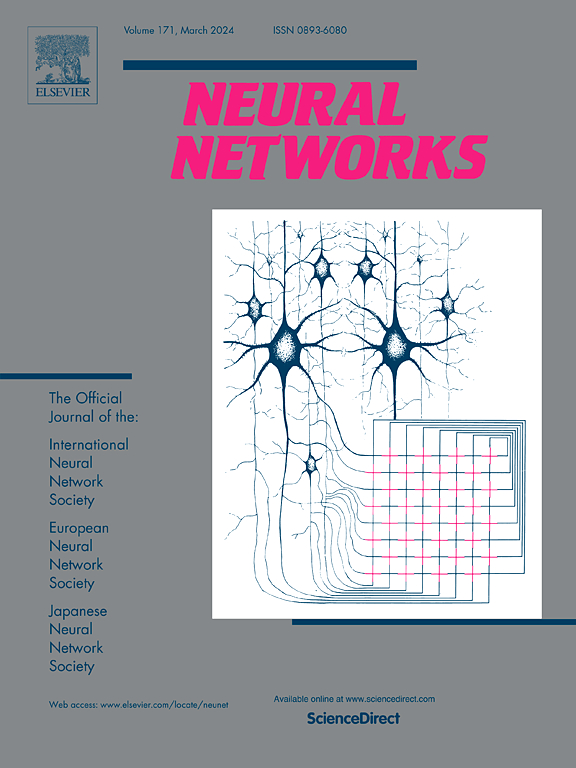Overlapping community detection via Layer-Jaccard similarity incorporated nonnegative matrix factorization
IF 6
1区 计算机科学
Q1 COMPUTER SCIENCE, ARTIFICIAL INTELLIGENCE
引用次数: 0
Abstract
As information modernization progresses, the connections between entities become more elaborate, forming more intricate networks. Consequently, the emphasis on community detection has transitioned from discerning disjoint communities towards the identification of overlapping communities. A variety of algorithms based on the sparse adjacency matrix, which are sensitive to edge connections, are suitable for detecting edge-sparse areas between overlapping communities but lack the ability to detect edge-dense areas within the overlapping communities. Additionally, most algorithms do not take into account multihop information. To mitigate the aforementioned limitations, we propose an innovative approach termed Layer-Jaccard similarity incorporated nonnegative matrix factorization (LJSINMF), which utilizes both the adjacency matrix and the Layer-Jaccard similarity matrix. Our method initially employs a newly proposed Onion-shell method to decompose the network into layers. Subsequently, the layer of each node is used to construct a Layer-Jaccard similarity matrix, which facilitates the identification of edge-dense areas within the overlapping communities and serves as a general approach for enhancing other nonnegative matrix factorization-based algorithms. Ultimately, we integrate the adjacency matrix and the Layer-Jaccard similarity matrix into the nonnegative matrix factorization framework to determine the node-community membership matrix. Moreover, integrating the Layer-Jaccard similarity matrix into other algorithms is a promising approach to enhance their performance. Comprehensive experiments have been conducted on real-world networks and the results substantiate that the LJSINMF algorithm outperforms most state-of-the-art baseline methods in terms of three evaluation metrics.
结合非负矩阵分解的Layer-Jaccard相似度重叠社团检测
随着信息现代化的发展,实体之间的联系变得更加精细,形成了更加复杂的网络。因此,对群落检测的重视已经从识别不相交的群落过渡到识别重叠的群落。基于稀疏邻接矩阵的各种算法对边缘连接敏感,适合于检测重叠群落之间的边缘稀疏区域,但缺乏检测重叠群落内部边缘密集区域的能力。此外,大多数算法不考虑多跳信息。为了减轻上述限制,我们提出了一种创新的方法,称为Layer-Jaccard相似性结合非负矩阵分解(LJSINMF),它同时利用邻接矩阵和Layer-Jaccard相似性矩阵。我们的方法最初采用了一种新提出的洋葱壳方法将网络分解成层。随后,利用每个节点所在的层来构建一个layer - jaccard相似矩阵,该相似矩阵有助于识别重叠群落内的边缘密集区域,并为增强其他基于非负矩阵分解的算法提供了一般方法。最后,我们将邻接矩阵和Layer-Jaccard相似矩阵整合到非负矩阵分解框架中,确定节点-群体隶属矩阵。此外,将Layer-Jaccard相似矩阵集成到其他算法中是提高其性能的一种很有前途的方法。在现实世界的网络上进行了全面的实验,结果证实LJSINMF算法在三个评估指标方面优于大多数最先进的基线方法。
本文章由计算机程序翻译,如有差异,请以英文原文为准。
求助全文
约1分钟内获得全文
求助全文
来源期刊

Neural Networks
工程技术-计算机:人工智能
CiteScore
13.90
自引率
7.70%
发文量
425
审稿时长
67 days
期刊介绍:
Neural Networks is a platform that aims to foster an international community of scholars and practitioners interested in neural networks, deep learning, and other approaches to artificial intelligence and machine learning. Our journal invites submissions covering various aspects of neural networks research, from computational neuroscience and cognitive modeling to mathematical analyses and engineering applications. By providing a forum for interdisciplinary discussions between biology and technology, we aim to encourage the development of biologically-inspired artificial intelligence.
 求助内容:
求助内容: 应助结果提醒方式:
应助结果提醒方式:


